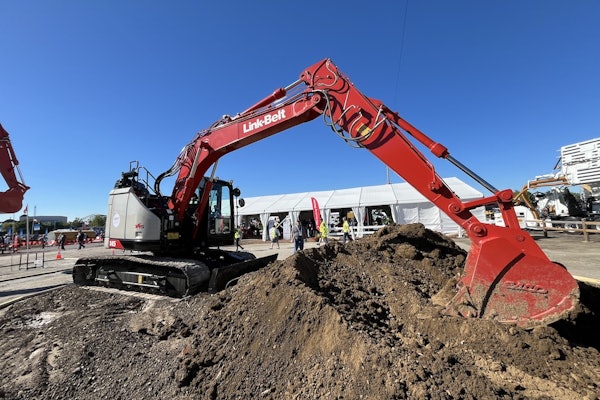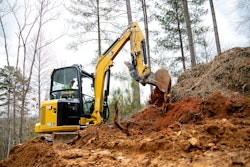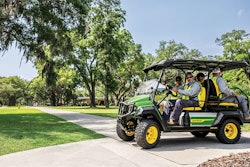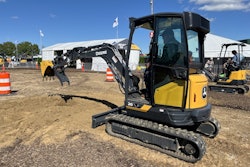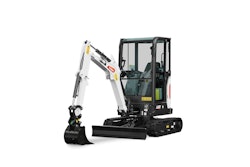Using a portable air compressor can be a simple process, but knowing you have the right one for the right application gets a bit more involved. Work site environment, application and air needs all affect the best use of these units.
Application affects the compressor type. In construction, the two most common portable compressors are reciprocating and rotary screw. While reciprocating compressors are hard-nosed, reliable machines, on many construction sites they have given way to the flexibility rotary screw units offer.
Reciprocating or rotary screw?
Reciprocating or piston compressors provide air power for work tools, machinery and manufacturing applications. Simple design and lower initial costs make them attractive, but their many moving parts can mean higher ongoing maintenance costs than rotary screw compressors.
“Reciprocating compressors have typically been the machine of choice for many years in the mobile air market,” says Dan Kowarski, sales manager, VMAC. “But they require receiver tanks because pneumatic tools need more air than reciprocating compressors can continuously deliver.”
Kowarski says continuous duty rotary screw compressors now have a prominent role in construction. “Rotary screws are becoming the workhorses in the industry,” he says. “Their ability to run continuous duty and provide air to match tool demands helps save time and money. Although pricier than reciprocating machines, rotary units have the advantage of an exceptional life span due to the simplicity of the system. They have no wear points with the exception of the front and back bearings.”
Rotary units employ two intermeshing screws to compress air. They operate at cooler temperatures than reciprocating compressors. Rotary units also provide air power in environments where too many compressors are impractical.
Keep noise level in mind during compressor use. Compressors – especially diesel driven units – get loud enough to affect communication on a jobsite. This especially presents a problem in areas with noise restriction, such as residential areas. Some manufacturers make mufflers to reduce noise levels at the intake valve, but if you are in proximity to a compressor for long periods of time, hearing protection is a must.
Compressor breakdown
Marc James, product manger for Ingersoll Rand, classifies small portable compressors as those with air flow between 75 and 250 cfm. They provide air for demolition applications and hand tools. Mid-range compressors generate 250 to 600 cfm and see use with larger applications such as painting, abrasive blasting or drilling. Units with 185 cfm are the most popular. Most tools require a pressure rating of 100 psi, but applications such as sandblasting or painting need 125 to 150 psi. Heavy-duty applications require 200 psi.
Reciprocating compressors can be single-stage or two-stage. Single-stage compressors draw in air and compress it with a single piston stroke. Two-stage compressors draw in air and compress it to an intermediate pressure. The air moves through a tube with an intercooler and into another chamber where it is further compressed by a smaller piston. Two-stage reciprocating compressors achieve pressures as high as 200 psi and top off at an air volume of around 100 cfm; single-stage units reach 150 psi.
Single-stage rotary screw compressors compress air through the meshing of a set of mated helical screws. These types of compressors can achieve air pressures of around 200 psi. For applications where extremely high air pressure is needed, a two-stage rotary screw compressor can be used, which uses a second set of screw rotors to further compress the air. The applications can achieve pressures beyond 350 psi.
Compressors between 75 and 250 cfm cost between $9,000 and $17,000, while units in the 250 to 600 cfm range cost $17,000 to $35,000, depending on specs. Price changes because of compressor part size, engine size and the amount of pressure generated.
Air flow variations
Air flow rate (measured in cfm), air pressure (measured in psi) and horsepower determine compressor output.
Attila Madarasz, product marketing manager for Atlas Copco’s portable compressor market in the United States, says there is a balance between cfm and psi. “Some applications require higher air flow, but lower pressure and vice versa,” he says. “In other applications, you may need both high flow and pressure. Usually our customers come to us with specifications of the cfm and psi they need.”
There are several different measurements of air flow. Standard cfm (scfm) measures the flow of air in ambient conditions, or air temperature at 68 degrees Fahrenheit, no relative humidity and air pressure at sea level. Actual cfm is the air flow at the compressor’s service valve, while the intake cfm (icfm) is the air flow measured at the compressor’s intake point. “There is always a certain cfm inside of the compressor, but by the time it gets discharged after flowing through filters, pipes, hoses and compressor parts, it is usually 5 to 10 percent lower,” Madarasz says.
A sense of duty
Because moving parts and compressed air generate heat, many manufacturers suggest a specific amount of time a compressor can run before it needs rest.
Duty cycle is important with reciprocating compressors. This percentage is best measured in a work environment with a standard ambient temperature of 72 degrees at 100 psi. For example, a compressor rated for a 25-percent duty cycle has an operation time of 10 minutes before it has to rest for 30 minutes. (For more on figuring a compressor’s duty cycle, see sidebar below.) Most rotary screw compressors on the market have 100-percent duty cycle.
Reciprocating compressors operate at higher temperatures than rotary screws and have lower rated duty cycles, although some manufacturers offer continuous duty cycle compressors. All applications don’t need units with 100-percent duty, and according to Madarasz, the price of compressors lowers as the duty rating lowers. Concrete breaking is an example of an application where compressor use is intermittent and not continuous.
Madarasz says some applications require higher pressure than air flow. Tools have both a cfm and psi rating and the amount of time an application takes depends on the specs of the compressor.
“Let’s say you have a tool that’s 100 psi with 200 cfm, and one with 100 psi with 300 cfm. They can do the same job,” Madarasz says, “but the one with 300 cfm will do the job quicker because it is a higher air flow rate.”
Filtering out down time
Proper compressor use and maintenance mean the difference between safe, efficient compression and long periods of down time. Changing the engine oil, compressor oil and air filters prevent costly damage and repairs.
“Many portable compressors are oil flooded, so you need to check your oil and change it,” says Chance Chartters, assistant sales manager, Kaeser Compressors. “A lot of construction sites are dusty and dirty, so the air going in has to be filtered. If the filter is clogged, then dirty air gets in and causes damage.”
How often you change filters and oil depends on the conditions of the work site and compressor usage.
Also, checking tools, hoses and parts prevents accidents and serious injury. “When compressed air is released suddenly, it can maim, tear or embed matter into the skin and bones. An air hose that is not secured can break legs,” Kowarski says. “Workers have lost eyes and broken ear drums through the misuse of compressed air. Poisonous particles can be blasted into the body where they immediately combine with the blood. Air, when forced into the bloodstream through a cut or pores of the skin, can cause serious injury or death.”
Condensation presents another maintenance issue for reciprocating compressors. Once air enters the intake valve, water vapor doesn’t disappear. Air tanks need drainage every day.
Madarasz says 1 percent of water in the compressor reduces the lifetime of its parts by 40 percent.
Some manufacturers offer compressors with automatic tank drains and inlet filters ($150 retail) designed to reduce condensation. Other manufactures offer different condensation solutions. Atlas Copco’s Oiltronix system, for example, controls compressor oil temperature to eliminate condensation.
Transporting your compressor
In many cases, portable compressor transport is as important a spec as its air flow and pressure.
“Smaller compressors only require a 1-ton pickup truck for transport,” Chartters says. “And you don’t need a CDL or any special endorsements on your license. In contrast, the 950-cfm compressor we sell is about 10,000 pounds. In that case, you need a special vehicle and endorsement to tow it.”
With a tow-behind, wheels, weight and handling require more attention. Ignoring these means damage to your vehicle, compressor or worse.
Improper weight distribution, for example, causes the trailer to fishtail.
Kowarski suggests that hitch weights for trailers should be 10 to 15 percent of the trailer’s gross weight for acceptable handling. Many tow-behinds become unstable traveling above 55 miles per hour.
“Anytime you are towing anything, you have to be aware that you have it connected properly and that you have safety chains,” Chartters says. “Some states require breakaway kits that activate the brakes if it becomes unhitched.”
Freeing your hitch
Truck-mounted compressors can be either deck-mounted or attached under the hood. Some units generate air, electricity or a combination of the two. Deck-mounted compressors use PTO drives or hydraulic drives, but make sure you have a truck big enough to house the compressor, says Darren McDowell, product marketing manager for onboard solutions, Ingersoll Rand. “The truck has to have a transmission with PTO capability and it has to be rugged enough so the engine and drivetrain can sustain a PTO apparatus. At a minimum, you need a class 4 or 5 truck.”
Above deck-mounted compressors take up space on the truck’s body and are hydraulically driven. Underhood units keep the truck’s work area free and do not need extra engine maintenance or fuel.
Truck-mounted units let you pull other equipment instead of just a tow-behind, “The typical mechanic isn’t going to need the amount of cfm produced with a tow-behind,” says Tim Worman, product manager for commercial vehicles, IMT. “In today’s market you can get 35 to 90 cfm from a top truck-mounted compressor that runs any tool out there.”
Compressor maintenance checklist
No matter what applications your compressor performs, it is a good idea to follow this maintenance checklist.
Compressor prefitters: Check and clean or replace; service frequency relates to conditions in operating environment.
Compressor fluid level: Should be at the “full” mark; change per manufacturer’s recommendation. Do not overfill.
Coolers: Check water quality, flow and temperature in water-cooled units. Check inlet filters and cooler surfaces on air-cooled surfaces.
Inlet filter cartridges: Remove, clean or replace.
Check for leaks: Check piping, flexible joint packings, control lines, control line fittings, clamps and connectors, valves, air pressure safety relief valves and pressure gauge connections.
Compressor: Maintain in a clean condition. Compressors should never leak fluid.
Belt: Check for wear or damage and re-tension as required.
Compressor temperature: Should be within manufacturer’s limits.
Record service and load hours: Recording both service and load hours makes compressors easier to maintain and troubleshoot.
Source: Kaeser Compressors
| Duty cycles: Duty cycle percentages are determined by taking the compressor’s on time and dividing it by the sum of its on time and off time. | ||
| Duty cycle rating | Maximum on time | Minimum off time |
| 10 percent | 3 minutes | 27 minutes |
| 15 percent | 6 minutes | 34 minutes |
| 20 percent | 8 minutes | 32 minutes |
| 25 percent | 10 minutes | 30 minutes |
| 30 percent | 13 minutes | 30 minutes |
| 33 percent | 15 minutes | 30 minutes |
| 100 percent | Continuous operation in the right conditions | |
| Average cfm requirements | |
| The chart below includes some common air tools and their average cfm measurements. Multiply the average cfm by four to get the required cfm rating. | |
| Tool | Average air consumption in cfm |
| 7-inch Angle Disc Grinder | 5 to 8 |
| Brad Nailer | 0.3 |
| Chisel/Hammer | 3 to 11 |
| Cut-Off Tool | 4 to 10 |
| Drill, Reversible or Straight-Line | 3 to 6 |
| Dual Sander | 11 to 13 |
| Framing Nailer | 2.2 |
| Grease Gun | 4 |
| Hydraulic Riveter | 4 |
| 3/8-inch Impact Wrench | 2.5 to 3.5 |
| 1/2-inch Impact Wrench | 4 to 5 |
| 1-inch Impact Wrench | 10 |
| Orbital Sander | 6 to 9 |
| 1/4-inch Ratchet | 2.5 to 3.5 |
| 3/8-inch Ratchet | 4.5 to 5 |
| Rotational Sander | 8 to 12.5 |
| Shears | 8 to 16 |
| Speed Saw | 5 |
| Source: Northern Tool and Equipment. There are more compressor buying tips at this site. |
|





